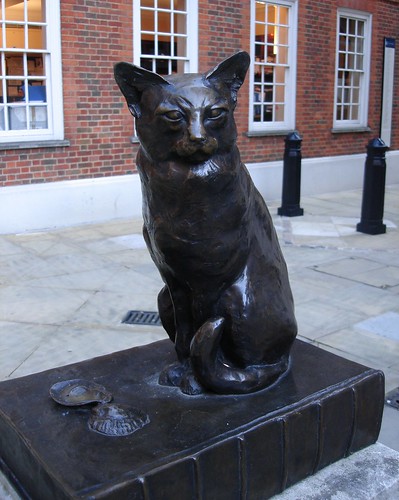 Pic by kjpickwick
Pic by kjpickwick
Outside a small house in Gough Square, just north of Fleet Street in London is a bronze statue of a proud and slightly fierce moggie. Why might this be?
The house in question was inhabited by Samuel Johnson, compiler of the very first English dictionary, and it was here that he compiled it (it was published in 1755). The eighteenth century dwelling is now a lovely little museum north of Fleet Street, and, as it’s not on a main thoroughfare, have an A-Z or Google Maps handy with you when visiting.
Since Johnson lived there, the townhouse has been a hotel, printer’s workshop and a social club for the Auxiliary Fire Service during the Second World War yet it still has ‘original features’ as they say on the property programmes, including original floorboards.
So who’s the cat?
Hodge is the name of this magnificent feline. He is shown seated on a copy of the famous dictionary. (And knowing how much my cats like to sit on top of anything made of paper, probably true to life.) Some oyster shells are on the book in front of him, as it was said by his friend Boswell that Johnson was wont to feed the cat with these shellfish (they weren’t the luxury food they are these days.)
Here’s a passsage written by Boswell about the characterful cat (nicked from Wikipedia):
Nor would it be just, under this head, to omit the fondness which he showed for animals which he had taken under his protection. I never shall forget the indulgence with which he treated Hodge, his cat: for whom he himself used to go out and buy oysters, lest the servants having that trouble should take a dislike to the poor creature. I am, unluckily, one of those who have an antipathy to a cat, so that I am uneasy when in the room with one; and I own, I frequently suffered a good deal from the presence of this same Hodge. I recollect him one day scrambling up Dr. Johnson’s breast, apparently with much satisfaction, while my friend smiling and half-whistling, rubbed down his back, and pulled him by the tail; and when I observed he was a fine cat, saying, ‘Why yes, Sir, but I have had cats whom I liked better than this;’ and then as if perceiving Hodge to be out of countenance, adding, ‘but he is a very fine cat, a very fine cat indeed.’
This reminds me of the ludicrous account which he gave Mr. Langton, of the despicable state of a young Gentleman of good family. ‘Sir, when I heard of him last, he was running about town shooting cats.’ And then in a sort of kindly reverie, he bethought himself of his own favourite cat, and said, ‘But Hodge shan’t be shot; no, no, Hodge shall not be shot.’
The statue was created by sculptor Jon Bickley and it was unveiled by the Mayor of London in 1997. The inscription reads ‘a very fine cat indeed’. And isn’t he just that?
Visiting Dr Johnson’s House
Website: www.drjohnsonshouse.org/history.htm
Address: 17 Gough Square, London , EC4A 3DE

Born in Belfast and now living in London, Julie McNamee is involved in internet marketing as a day job and blogging as a hobby. She’s interested in all things quirky and Fortean, as well as art, photography and theatre. Her blog Quirky Travel, specializes in London and Paris top tips and off the beaten path information with subjects such as London film locations and unusual Paris museums.








